| Author |
Message |
Jason Mather

|
 Posted: Sun 23 May, 2010 12:12 pm Post subject: New type XVI from Cervenka Posted: Sun 23 May, 2010 12:12 pm Post subject: New type XVI from Cervenka |
 |
|
Just some pics of my new sword that is on its way from Vladimir. This is my second from him, the first is a rapier. I will be making the grip, scabbard, and suspension myself as time allows.
 Attachment: 160.36 KB Attachment: 160.36 KB
[ Download ]
 Attachment: 157.63 KB Attachment: 157.63 KB
[ Download ]
To be nobody but yourself in a world that's doing its best to make you somebody else, is to fight the hardest battle you are ever going to fight. Never stop fighting.
|
|
  |
 |
|
Scott Kowalski
Location: Oak Lawn, IL USA Joined: 24 Nov 2006
Posts: 818
|
 Posted: Sun 23 May, 2010 1:02 pm Post subject: Posted: Sun 23 May, 2010 1:02 pm Post subject: |
 |
|
That really looks nice Jason. I hope that you post pictures when you are done with this. Is the blade based off an extant piece or did Vladimir have free reign to design it? The only thing that throws me is that without the fuller it really makes me think more of a type XVIII then a XVI. Though I know I have not seen every XVI pictured I do not remember seeing one without a fuller. No knock on the blade, it looks superb as I said before.
Scott
Chris Landwehr 10/10/49-1/1/09 My Mom
|
|
  |
 |
|
Sam Barris
|
 Posted: Sun 23 May, 2010 1:11 pm Post subject: Posted: Sun 23 May, 2010 1:11 pm Post subject: |
 |
|
I concur. I'd have called that as an XVIII as well. Well, whatever it is, you're going to have a cool sword! Can't wait to see her finished. 
Pax,
Sam Barris
"Any nation that draws too great a distinction between its scholars and its warriors will have its thinking done by cowards, and its fighting done by fools." —Thucydides
|
|
   |
 |
Jason Mather

|
 Posted: Sun 23 May, 2010 6:13 pm Post subject: Posted: Sun 23 May, 2010 6:13 pm Post subject: |
 |
|
Funny you should mention that, I asked him for a type XVI, then he gave me the price with and without the fuller. I went for the non fuller price. Thanks for the correction, I will refer to it as a XVIII from here on out. It is not based on anything extant, I simply explained what I was after and he took it from there. My request was a simple, functional arming sword in the 1300-25 time frame, non-sharpened for practical use. I am pleased indeed. Less than a week to go and its here.
To be nobody but yourself in a world that's doing its best to make you somebody else, is to fight the hardest battle you are ever going to fight. Never stop fighting.
|
|
  |
 |
|
P. Cha
|
 Posted: Sun 23 May, 2010 9:56 pm Post subject: Posted: Sun 23 May, 2010 9:56 pm Post subject: |
 |
|
|
Not only that, but it looks like a hollow ground geometry...which is more of a XVIII then a XVI feature.
|
|
  |
 |
Roger Hooper

|
 Posted: Mon 24 May, 2010 12:01 am Post subject: Posted: Mon 24 May, 2010 12:01 am Post subject: |
 |
|
| Jason Mather wrote: | | My request was a simple, functional arming sword in the 1300-25 time frame, non-sharpened for practical use. |
1300 to 1325 is a little early for an XVIII. For what it's worth, it looks more like a XV to me.
|
|
  |
 |
|
P. Cha
|
 Posted: Mon 24 May, 2010 9:12 am Post subject: Posted: Mon 24 May, 2010 9:12 am Post subject: |
 |
|
| Jason Mather wrote: | | ... non-sharpened for practical use... |
Umm just curious when you say practical use, do you mean as a drill/sparring sword? Because that tip is AWEFULLY sharp looking.
|
|
  |
 |
Hugo Voisine

|
 Posted: Mon 24 May, 2010 9:17 am Post subject: Posted: Mon 24 May, 2010 9:17 am Post subject: |
 |
|
Indeed. I have a blunt sword by mister Cervenka too. I can't use it for sparring or two-person drills because of the extra-pointy tip, but it's ok for solo drills... is that what you mean ?
Nice looking sword by the way. I'm curious to see the final result. 
« Que dites-vous ?... C'est inutile ?... Je le sais !
Mais on ne se bat pas dans l'espoir du succès !
Oh ! non, c'est bien plus beau lorsque c'est inutile ! »
|
|
  |
 |
|
David Sutton
|
 Posted: Mon 24 May, 2010 2:11 pm Post subject: Posted: Mon 24 May, 2010 2:11 pm Post subject: |
 |
|
I'd say it was firmly in the Type XV catagory.
I think its quite reminiscent of this Italian Type XV sword:

The hollow grinding looks very nicely done should be a beautiful piece when its finished. 
'Reserve your right to think, for even to think wrongly is better than not to think at all'
'To teach superstitions as truth is a most terrible thing'
Hypatia of Alexandria, c400AD
|
|
  |
 |
|
Neil Langley
Location: Stockport, UK Joined: 23 Jan 2006
Posts: 112
|
 Posted: Mon 24 May, 2010 2:30 pm Post subject: Posted: Mon 24 May, 2010 2:30 pm Post subject: |
 |
|
| Jason Mather wrote: | | Funny you should mention that, I asked him for a type XVI, then he gave me the price with and without the fuller. |
A very nice example of a hollow ground blade. I am curious, was the fullered blade that was quoted for also hollow ground as well (I would have though a simple fuller was cheaper)? If so, that would be an interesting blade!
Oh, for what it's worth I see a type XVIII here (hollow ground and taper at the point).
Neil.
|
|
  |
 |
Jason Mather

|
 Posted: Mon 24 May, 2010 2:54 pm Post subject: Posted: Mon 24 May, 2010 2:54 pm Post subject: |
 |
|
Thanks for all the input. I got it today, way ahead of schedule. It is a bit pointy but I am not above filing/altering the point to make it suit my needs. Even without the grip this thing handles brilliantly. Really, the category it fits in is no matter. It is exactly what I was after and will suit my needs perfectly.The difference in price was 30-40 bucks, and the beautiful hollow grind was an unknown bonus. I was expecting a simple diamond cross section. Within the next week I will mount the cross and peen the pommel. I also have to decide if it needs a peen block. I am leaning toward no, any opinions?
To be nobody but yourself in a world that's doing its best to make you somebody else, is to fight the hardest battle you are ever going to fight. Never stop fighting.
|
|
  |
 |
Michael Edelson

|
 Posted: Mon 24 May, 2010 3:13 pm Post subject: Posted: Mon 24 May, 2010 3:13 pm Post subject: |
 |
|
The sword is not a XV, because it lacks the XV's purpose driven point (which is to slide inside mail rings--see photo of a proper XV above). Those needle-like points were not there just to look cool. Although, considering the owner is going to file it down, it might be a XV, since we can always pretend it had such a point before the aforementioned alteration.
New York Historical Fencing Association
www.newyorklongsword.com
Byakkokan Dojo
http://newyorkbattodo.com/
|
|
   |
 |
Chad Arnow
myArmoury Team


|
 Posted: Mon 24 May, 2010 4:03 pm Post subject: Posted: Mon 24 May, 2010 4:03 pm Post subject: |
 |
|
| Michael Edelson wrote: | | The sword is not a XV, because it lacks the XV's purpose driven point (which is to slide inside mail rings--see photo of a proper XV above). Those needle-like points were not there just to look cool. Although, considering the owner is going to file it down, it might be a XV, since we can always pretend it had such a point before the aforementioned alteration. |
Actually, the definition of a Type XV blade is one whose edges taper in mostly a straight line to an acute point. This sword qualifies, even though the point could be more acute. If you check out our Type XV spotlight, you'll see one or two swords with less-acute points.
The hollow-grind points to a more likely dating of 15th century than early 14th. Diamond cross-section swords are seen in art in the 13th century, but typically ones with a flattened cross-section. The hollow-ground section seems to be of a later date.

ChadA
http://chadarnow.com/
|
|
    |
 |
Michael Edelson

|
 Posted: Mon 24 May, 2010 4:20 pm Post subject: Posted: Mon 24 May, 2010 4:20 pm Post subject: |
 |
|
| Chad Arnow wrote: | | Michael Edelson wrote: | | The sword is not a XV, because it lacks the XV's purpose driven point (which is to slide inside mail rings--see photo of a proper XV above). Those needle-like points were not there just to look cool. Although, considering the owner is going to file it down, it might be a XV, since we can always pretend it had such a point before the aforementioned alteration. |
Actually, the definition of a Type XV blade is one whose edges taper in mostly a straight line to an acute point. This sword qualifies, even though the point could be more acute. If you check out our Type XV spotlight, you'll see one or two swords with less-acute points.
|
Although not every point on the spotlight page ends in a proper needle, there is not a single point there that would not slide easily inside a 8mm mail ring.
While the texbook definition of XV may not include a very acute point, I feel it should, as the overwhelming majority have them, and if they don't I think it's becuase it was broken and reshaped.
New York Historical Fencing Association
www.newyorklongsword.com
Byakkokan Dojo
http://newyorkbattodo.com/
|
|
   |
 |
Chad Arnow
myArmoury Team


|
 Posted: Mon 24 May, 2010 4:37 pm Post subject: Posted: Mon 24 May, 2010 4:37 pm Post subject: |
 |
|
| Michael Edelson wrote: | | While the texbook definition of XV may not include a very acute point, I feel it should, as the overwhelming majority have them, and if they don't I think it's becuase it was broken and reshaped. |
Well, Oakeshott didn't get that specific in his system.  The broken-re-shaped theory is interesting. I'd be curious if it holds up to an inspection of a number of originals. I may have to look that up sometime. The broken-re-shaped theory is interesting. I'd be curious if it holds up to an inspection of a number of originals. I may have to look that up sometime. 

ChadA
http://chadarnow.com/
|
|
    |
 |
Jason Mather

|
 Posted: Mon 24 May, 2010 4:58 pm Post subject: Posted: Mon 24 May, 2010 4:58 pm Post subject: |
 |
|
Here are some pics of the recently fastened cross, note the mashing of the metal around the tang. Solid as a rock. The tools used are on the bench beside the sword.
 Attachment: 46.29 KB Attachment: 46.29 KB
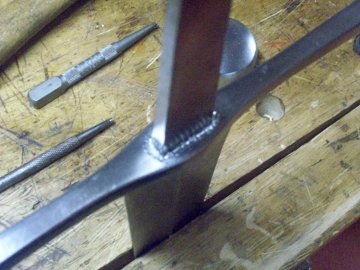
 Attachment: 112.97 KB Attachment: 112.97 KB
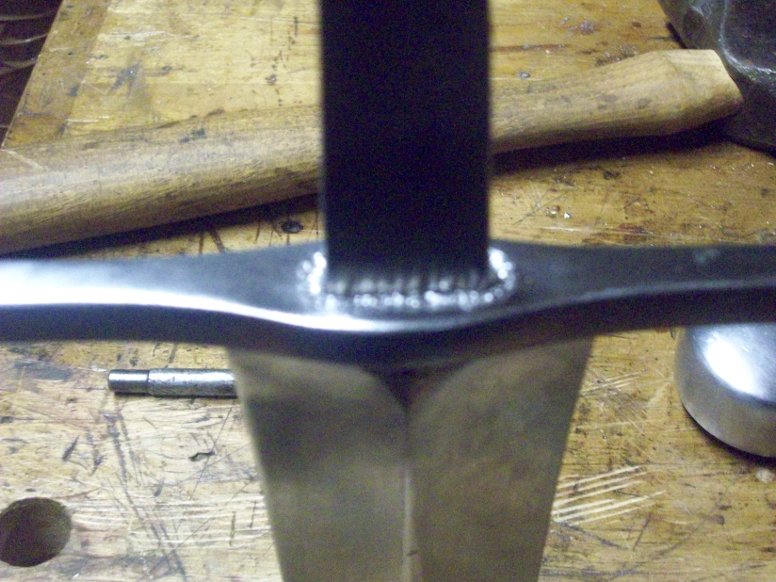
 Attachment: 119.82 KB Attachment: 119.82 KB
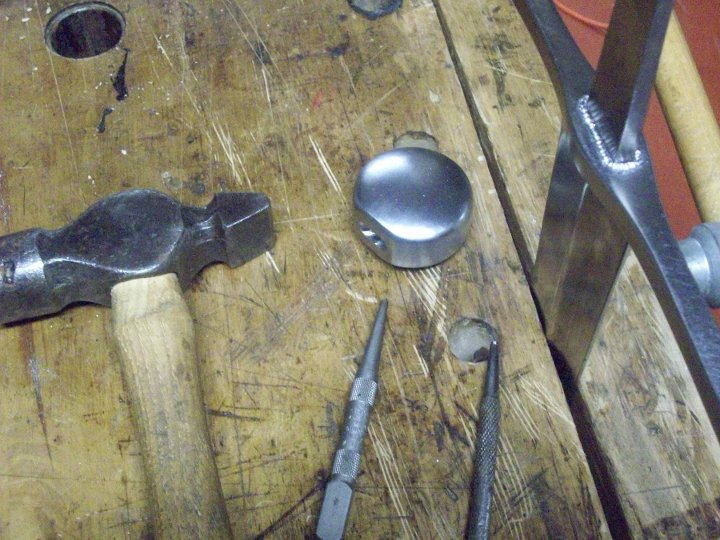
To be nobody but yourself in a world that's doing its best to make you somebody else, is to fight the hardest battle you are ever going to fight. Never stop fighting.
|
|
  |
 |
Michael Edelson

|
 Posted: Mon 24 May, 2010 5:00 pm Post subject: Posted: Mon 24 May, 2010 5:00 pm Post subject: |
 |
|
| Chad Arnow wrote: |
Well, Oakeshott didn't get that specific in his system.  The broken-re-shaped theory is interesting. I'd be curious if it holds up to an inspection of a number of originals. I may have to look that up sometime. The broken-re-shaped theory is interesting. I'd be curious if it holds up to an inspection of a number of originals. I may have to look that up sometime.  |
I think it's worth doing. The few that I've seen seemed...well...off. Like the lines of the sword don't mesh without the point. However, there are so many XVs and XVas with these super acute points that I don't think it's a hard sell.
You really have to think about what these swords were for, how they were used. Why have a point like that on a stiff war sword? If you're going to be poking textile armor, a sharper, more rounded point would serve you better. However, having tested a XVa on mail, I can tell you they're great at popping rings from the inside, and even if they don't, they go far enough in without breaking a single link to cause a world of hurt.
This is an Albion Talhoffer's point in 6mm mail links, and this point has been reworked several times and is not as acute as it used to be.
 Attachment: 96.81 KB Attachment: 96.81 KB
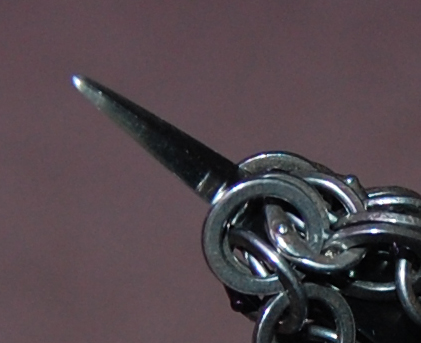
New York Historical Fencing Association
www.newyorklongsword.com
Byakkokan Dojo
http://newyorkbattodo.com/
|
|
   |
 |
Michael Edelson

|
 Posted: Mon 24 May, 2010 5:09 pm Post subject: Posted: Mon 24 May, 2010 5:09 pm Post subject: |
 |
|
| Jason Mather wrote: | | Here are some pics of the recently fastened cross, note the mashing of the metal around the tang. Solid as a rock. The tools used are on the bench beside the sword. |
That looks great, like a weld. Man, now I have to get a sword that's not put together. That looks like a blast.
New York Historical Fencing Association
www.newyorklongsword.com
Byakkokan Dojo
http://newyorkbattodo.com/
|
|
   |
 |
Jason Mather

|
 Posted: Mon 24 May, 2010 6:20 pm Post subject: Posted: Mon 24 May, 2010 6:20 pm Post subject: |
 |
|
Now the pommel. Again, the tools used are on the bench.
 Attachment: 117.86 KB Attachment: 117.86 KB
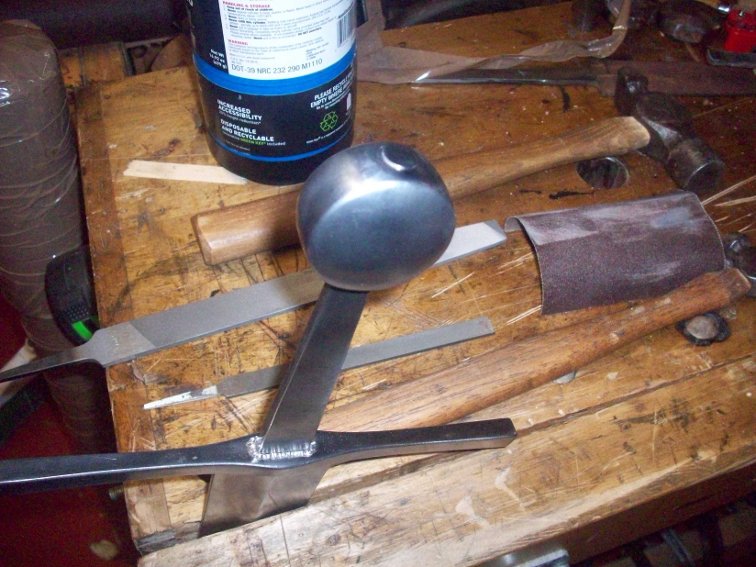
 Attachment: 118.81 KB Attachment: 118.81 KB
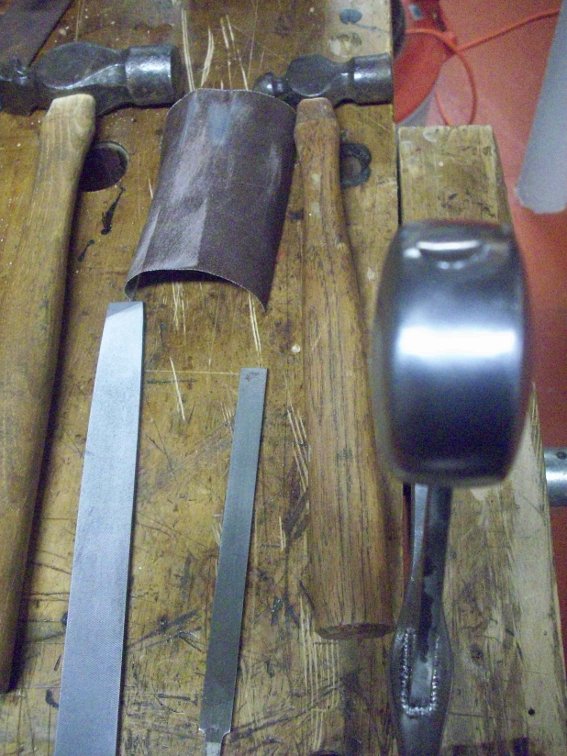
 Attachment: 114.89 KB Attachment: 114.89 KB

To be nobody but yourself in a world that's doing its best to make you somebody else, is to fight the hardest battle you are ever going to fight. Never stop fighting.
|
|
  |
 |
|
Peter Johnsson
Industry Professional
|
 Posted: Mon 24 May, 2010 9:54 pm Post subject: Posted: Mon 24 May, 2010 9:54 pm Post subject: |
 |
|
| Chad Arnow wrote: | | Michael Edelson wrote: | | The sword is not a XV, because it lacks the XV's purpose driven point (which is to slide inside mail rings--see photo of a proper XV above). Those needle-like points were not there just to look cool. Although, considering the owner is going to file it down, it might be a XV, since we can always pretend it had such a point before the aforementioned alteration. |
Actually, the definition of a Type XV blade is one whose edges taper in mostly a straight line to an acute point. This sword qualifies, even though the point could be more acute. If you check out our Type XV spotlight, you'll see one or two swords with less-acute points.
The hollow-grind points to a more likely dating of 15th century than early 14th. Diamond cross-section swords are seen in art in the 13th century, but typically ones with a flattened cross-section. The hollow-ground section seems to be of a later date. |
I think it is a mistake to try to fit all contemporary swords into a system intended to classify historical swords. We can only do this if the contemporary sword is really made after the example and according to the traditional forms of the European sword. Even a sword made today following the definitions Oakeshott put down to define a type, does not necessarily have much in common with actual historical swords: there are too many important aspects left out in the classification system.
Oakeshott did not go into many details. Outside the definitions he set down, there are many typical details that swords of any given type have in common, or typical variations within a type that combine in certain ways. If you do not pay attention to these aspects, themes and details, there result can be very different from any original weapon.
Trying to fit a contemporary sword into the Oakeshott typology can be like fitting a square peg in a round hole. It may work, but only if some force, inventiveness, and determination is involved....
This in itself does not reflect on the purposefulness of the sword. It may work perfectly for its intended role even if it does not compare other than superficially to any historical sword.
Swords made today for sparring is a perfect example. You have to make adjustments in the shape, if the sword is to be safe to use. The traditional forms are deadly and that is something we may not always want to mimic too closely. But after these adjustments it is no longer meaningful to define the sword according to the Oakeshott system. A training sword may be made to mimic the heft and feel of a certain type, but that is as close as we can hope to get with a training sword.
|
|
   |
 |
|
|

